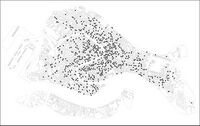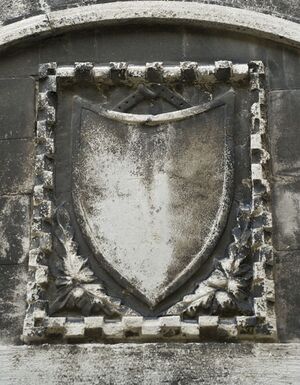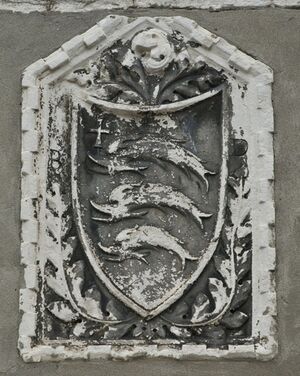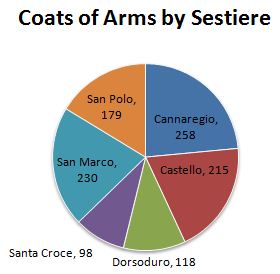Coats of Arms: Difference between revisions
No edit summary |
No edit summary |
||
| (6 intermediate revisions by the same user not shown) | |||
| Line 3: | Line 3: | ||
|totalnumber=1,061 | |totalnumber=1,061 | ||
|totalnumbermissing=12 | |totalnumbermissing=12 | ||
}} | |||
'''Coats of Arms''', also known as ''stemmi'' (''stemma'', singular) in Italian, were formerly used to indicate ownership of a building. They are also a sub-set of [[Material Culture|material culture]]. The wealthier families in the city would often recreate their family crest out of stone, marble, or some other substance, and hang it outside their [[palaces]]. Most coats of arms are symbolic of the family name in some way. In the event that a new owner moved into the building, the coat of arms would often be removed or carved off. | '''Coats of Arms''', also known as ''stemmi'' (''stemma'', singular) in Italian, were formerly used to indicate ownership of a building. They are also a sub-set of [[Material Culture|material culture]]. The wealthier families in the city would often recreate their family crest out of stone, marble, or some other substance, and hang it outside of their [[:Category:Palaces|palaces]]. Most coats of arms are symbolic of the family name in some way. In the event that a new owner moved into the building, the coat of arms would often be removed or carved off. | ||
[[Image:figure12_blankstemma.jpg|right|thumb|A blank stemma, the previous family's symbols having been removed when new owners took possession of the property]] | [[Image:figure12_blankstemma.jpg|right|thumb|A blank stemma, the previous family's symbols having been removed when new owners took possession of the property]] | ||
[[Image:figure15_dolfin.jpg |right|thumb|A Dolfin family "talking" stemma, featuring three dolphins.]] | [[Image:figure15_dolfin.jpg |right|thumb|A Dolfin family "talking" stemma, featuring three dolphins.]] | ||
| Line 11: | Line 11: | ||
===Talking Coats of Arms=== | ===Talking Coats of Arms=== | ||
One particular category of ''stemmi'' is special because of the way it communicates information about its owner: known as "talking" coats of arms, these ''stemmi'' use symbols with a pictorial or phonetic reference to the name of the family being represented. Some of the more obvious examples include the Dolfin family (a dolphin), the Da Ponte family (a bridge), and the Dalle Rose family (roses). The Barbarigo family used a beard on their stemmi, because "''barba''" is Italian for beard. Even more creatively, the Erizzo family used the letter “E” and a porcupine as their family symbol, as "''riccio''" is an Italian word for porcupine, or "''rizzo''" in the [[Venetian | One particular category of ''stemmi'' is special because of the way it communicates information about its owner: known as "talking" coats of arms, these ''stemmi'' use symbols with a pictorial or phonetic reference to the name of the family being represented. Some of the more obvious examples include the Dolfin family (a dolphin), the Da Ponte family (a bridge), and the Dalle Rose family (roses). The Barbarigo family used a beard on their stemmi, because "''barba''" is Italian for beard. Even more creatively, the Erizzo family used the letter “E” and a porcupine as their family symbol, as "''riccio''" is an Italian word for porcupine, or "''rizzo''" in the [[Venetian Language|Venetian dialect]]. | ||
==Statistics== | ==Statistics== | ||
| Line 23: | Line 23: | ||
For general information pertaining to the sources of damage to Venetian coats of arms, please see the [[Damage to public art]] page. | For general information pertaining to the sources of damage to Venetian coats of arms, please see the [[Damage to public art]] page. | ||
For general information pertaining to the restoration and preservation of Venetian coats of arms, please see the [[Restoration and preservation of public art]] page. | For general information pertaining to the restoration and preservation of Venetian coats of arms, please see the [[Public art preservation|Restoration and preservation of public art]] page. | ||
Specific information regarding the damage and restoration needs of each coat of arms can be found on the pages dedicated to each individual coat of arms, as listed in the map below and in the navigation box under the "See Also" section of this page. | Specific information regarding the damage and restoration needs of each coat of arms can be found on the pages dedicated to each individual coat of arms, as listed in the map below and in the navigation box under the "See Also" section of this page. | ||
| Line 37: | Line 37: | ||
==Bibliography== | ==Bibliography== | ||
* | *Rizzi, Alberto. "Scultura Esterna a Venezia." Stamperia di Venezia Editrice, 1987. | ||
*[http://www.wpi.edu/Pubs/E-project/Available/E-project-122610-103308/ 2010 WPI PreserVenice Project Team] | *[http://www.wpi.edu/Pubs/E-project/Available/E-project-122610-103308/ 2010 WPI PreserVenice Project Team] | ||
*[http://www.wpi.edu/Pubs/E-project/Available/E-project-122207-150125/ 2008 WPI PreserVenice Project Team] | *[http://www.wpi.edu/Pubs/E-project/Available/E-project-122207-150125/ 2008 WPI PreserVenice Project Team] | ||
| Line 48: | Line 48: | ||
[[Category:Coats of Arms]] | [[Category:Coats of Arms]] | ||
[[Category:Decorative Artifacts]] | |||
[[Category:Public Art]] | [[Category:Public Art]] | ||
[[Category:Material Culture]] | |||
Latest revision as of 12:47, 9 December 2012
 | |
| Total Number | 1,061 |
|---|---|
| Total Number Missing | 12 |
Coats of Arms, also known as stemmi (stemma, singular) in Italian, were formerly used to indicate ownership of a building. They are also a sub-set of material culture. The wealthier families in the city would often recreate their family crest out of stone, marble, or some other substance, and hang it outside of their palaces. Most coats of arms are symbolic of the family name in some way. In the event that a new owner moved into the building, the coat of arms would often be removed or carved off.


Types
Talking Coats of Arms
One particular category of stemmi is special because of the way it communicates information about its owner: known as "talking" coats of arms, these stemmi use symbols with a pictorial or phonetic reference to the name of the family being represented. Some of the more obvious examples include the Dolfin family (a dolphin), the Da Ponte family (a bridge), and the Dalle Rose family (roses). The Barbarigo family used a beard on their stemmi, because "barba" is Italian for beard. Even more creatively, the Erizzo family used the letter “E” and a porcupine as their family symbol, as "riccio" is an Italian word for porcupine, or "rizzo" in the Venetian dialect.
Statistics
- The oldest coat of arms is located in Dorsoduro and dates from 1300 AD.
- The most recent coat of arms is located in Cannaregio and dates from 1800 AD.
- The coat of arms in the most need of restoration is located in Cannaregio and dates from 1447 AD.
Damage and Preservation
For general information pertaining to the sources of damage to Venetian coats of arms, please see the Damage to public art page.
For general information pertaining to the restoration and preservation of Venetian coats of arms, please see the Restoration and preservation of public art page.
Specific information regarding the damage and restoration needs of each coat of arms can be found on the pages dedicated to each individual coat of arms, as listed in the map below and in the navigation box under the "See Also" section of this page.
Location
{{#compound_query: |Coats of Arms;?Coordinates;?PV ID;icon=Red Marker.png |Coordinates::+;?Coordinates;?PV ID;icon=Blue Marker.png |limit=500 |height=500px |format=map }}
See Also
| ||||||||
References
NULL
Bibliography
- Rizzi, Alberto. "Scultura Esterna a Venezia." Stamperia di Venezia Editrice, 1987.
- 2010 WPI PreserVenice Project Team
- 2008 WPI PreserVenice Project Team
- 2007 WPI PreserVenice Project Team
- 2000 WPI PreserVenice Project Team
